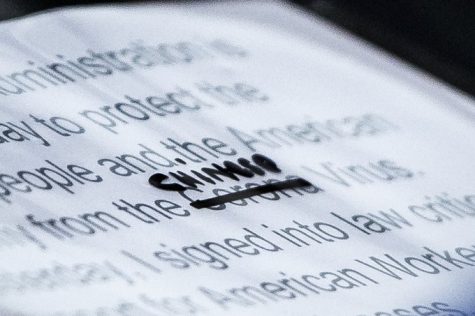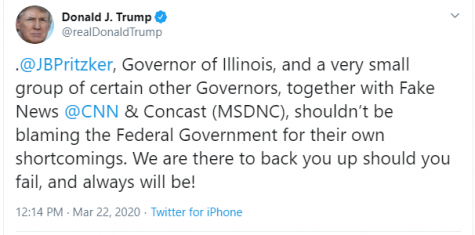With Great Power Came Scant Responsibility
Distrust in science, federal cutbacks, and pure narcissism have exposed President Trump’s weakness in the face of the COVID-19 outbreak.
President Trump’s worst traits have been amplified as the coronavirus outbreak tears away the economic gains he once took credit for.
The Coronavirus pandemic is an ever-changing global crisis, and the sheer amount of information (and misinformation) being thrown our way can be profoundly frustrating. However, there’s one thing that has stayed fairly constant throughout this period of incredible uncertainty: the criticism of the Trump administration hasn’t ceased — and for good reason.
As a member of a liberal household, I can attest to the fact that CNN and MSNBC have monopolies over our TV when it comes to news. Both networks joyously take part in highlighting the president’s failures, especially as of late, and so I am well aware of them.
However, my goal is not to criticize the administration in its entirety but rather pinpoint the preventable shortcomings that have occurred thus far. Obviously, now isn’t the time to politicize the issue either, but it seems that Trump doesn’t understand that. Much of Trump’s botched COVID-19 response is rooted in a sneaky attempt at securing re-election and furthering his own political and personal agenda.
Perhaps the costliest and most consequential action occurred months before the pandemic — when Corona was known as just a beer brand. In 2018, national security adviser John Bolton fired the White House pandemic response team under Trump’s orders. President Obama had assembled the team after the Ebola outbreak to prepare for possible future outbreaks. Many of Trump’s actions have focused solely on rolling back Obama-era policies and developments, and this is a clear example of such. It seemed almost laughable when Trump put Vice-President Pence in charge of the Coronavirus response, in a reactionary measure to the spike in cases, when there could have been an existing group of experts planning in anticipation of a pandemic.
As the virus spread across the globe and took thousands of lives in late February and early March, Trump displayed an jaw-dropping amount of denial by quickly dismissing the threat of COVID-19 and repeatedly calling it a “hoax.” And of course, he blamed Democrats for using the virus as a political talking point. There is certainly just a little bit of irony in his statement.
You would certainly think that after Italy’s delayed response, we would be better prepared. But experts predict the US is two to three weeks behind Italy, and a peak in the number of cases has not yet been reached. Perhaps if some of the preliminary steps were already in effect, we would be able to see quicker results.
In times of hardship or crisis, people automatically turn to the government for help. But Trump’s prolonged period of inaction, rooted in a bedrock Republican mistrust of big government, spurred governors to take matters into their own hands instead, imposing statewide closures and lockdowns.
Until the stocks began to fall.
Trump has frequently cited the growing economy, leading his supporters to believe that he and he alone deserves credit for the bull market. But the economy is cyclical. It’s bound to worsen, and it’s bound to improve, depending on a multitude of factors. Trump’s reelection chances depend on the timing of that cycle. If the economy continues to falter in response to the COVID-19 outbreak, he’ll have to face the blame (which, of course, he’ll deny), which is why he’d rather have the country open by Easter than continue to enforce the measures needed to flatten the curve and save lives.
At a time such as this, purposely creating division only leads to more unnecessary problems, but that is exactly what Trump has done.

An important and simple question from an NBC reporter to Trump– “what would you say to Americans who are scared?” — was met with extreme hostility; Trump proceeded to call him a “bad reporter” practicing “sensationalism.” The question was a golden opportunity for Trump to reassure the general public with a positive message, and it turned into quite the opposite.
There is also a fair amount of controversy over Trump’s reference to COVID-19 as the “Chinese virus,” Some cite it as racist, and others’ defense is that it originated in China. But there is a larger, yet related problem, as shown in this photograph of Trump’s speech.
Intentionally crossing out “Corona” in Coronavirus and replacing it with “Chinese” only adds fuel to the growing fire. Asian-Americans have borne the brunt of verbal and physical attacks for absolutely no fault of theirs, and as a child of immigrants, I feel especially angered to see a President behave in such a divisive way towards a certain group.
And of course, the tweets haven’t stopped either, because the news organizations Trump loathes so much still put out “fake news.” And new ones have been added to the list.

New York governor Andrew Cuomo isn’t explicitly mentioned in the tweet, as Trump most likely realizes that Cuomo has displayed far greater leadership and has become a prominent figure in the battle against the virus. Comcast took a significant step in opening a national, free Wi-Fi network for any Americans in need. Yet that is what Trump had to say to them.
In the last few days, the news has shifted from Trump to Congress, as the Senate sparred over versions of coronavirus relief bills. Despite what conservative news outlets would have us believe, Senator Mitch McConnell’s bill was hardly a simple measure to provide struggling American families with much-needed cash; it focused heavily on corporations, and allowed the Treasury to select firms to receive loans, meaning that Trump’s private businesses could benefit. But of course, Trump remained in denial and refused to answer.
It has taken thousands of global deaths for the seriousness of the situation to fully make its way into the minds of many Americans, including the President. There is definitely a large degree of pressure on the government to act quickly and responsibly. In the wake of this pandemic, Trump had the chance to prove to the American people that he could be that responsible leader — but the truth is, he isn’t one. And in the absence of such needed leadership, we are forced to look out for ourselves and our neighbors as best as we can.

Anjana Suresh is a senior at NASH. She is a part of the rowing team and has been involved with Key Club. She enjoys eating pickles, playing solitaire, and meeting new people.


